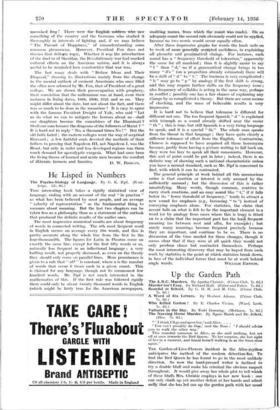He Lisped in Numbers
This interesting book takes a rigidly statistical view of language, ending with an account of the real " in practice " as what has been .believed by most people, and an average " velocity of representation " as the fundamental thing to measure about meaning. But the last two chapters can be taken less-as a philosophy than as a statement of the outlook that-produced the definite results of the earlier ones. •
The most impressive nuniericat results are about frequency of words in connected writing. The nth most frequent word in English- occurs on average every 10n words, and this is pretty accurate along the whole line from the first to the four-thousandth. The figures for Latin in Plautus come on exactly the same line, except for the first fifty words or so, naturally less frequent in an inflectional language ; a very baffling result, nut properly discussed, as even on the theory they should only come on parallel lines. More prominence is given to a rule that " ab2 " is constant, where a is the number of words that occur b. times each in a given count. This is claimed for any language, though not its commonest few hundred words. Mr. Zipf is not much interested in the . mathematics of this. If the first rule was followed rigidly- there could only be about twenty thousand words in English (which might be fairly true for the American newspapers, -Orrdtting nanicS, 7 frOni which -the436filit - On an adequate count the second rule obviously oould not be applied, .Because no two words would occur equally often.
After these impressive graphs for words the book sails' on to work of more'•genetielfy accepted usefulness, in explaining all phonetic add traikaatical chabge. For instance, each sound has a " frequency threshold of toleration," apparently the same for all mankind.; thus it-is slightly easier to say
"t " than !.1 d,".fisgo- if kr grammatical change brings in too Many " d's " (on a proportion already estimated) there will be a shift of " d " to " V,' The business is very complicated : " " may go to " p "'by analogy if the first shift is strong, add this may require further shifts on the frequency issue ; also frequency of syllables is acting in the same way, perhaps in conflict ; possibly one has, a fair chance of explaining any change by so complicated a theory. But there are some means of checking, and the mass of believable results is very impressive
It is hard not to believe that tolerance is different for different nat ons. The too frequent Spanish " d " is explained with triumph as a sound already shifted near the easier " th " ; this is true, but still Spanish is a very tiring language to speak, and it is a special " th." The whole man speaks from the throat in that language ; they have quite clearly a different tolerance of effort from the English. Contrariwise, Chinese is supposed to have acquired all those homonyms because, partly from having a picture writing to fall back on, they were too lazy to speak all their consonants. However, this sort of point could be put in later ; indeed, there is no definite way of showing such a national characteristic unless you have a normal standard, such as Mr. Zipf is concerned to find, with which it can be contrasted.
The general principle at work behind all this unconscious order is that emotion or interest is only aroused by the sufficiently unusual ; but the discussion of this is rather unsatisfying. Many words, though common, contrive to carry stock. emotions, .and an easy. sound like " t," if it falls below its " lower threshold of frequency," tends to attract a new sound for emphasis (e.g., becoming " is ") instead of conveying emphasis alone. For statistics, the claim that accent falls on what is felt to be the important element in a word (or by analogy from cases where this is tru) is fitted on to a claim that the important part has the lens, frequent meaning (as between root amid affix, for example) ; but surely many meanings become frequent precisely because they are impOrtant, and continue to be so. There is no discussion of the time needed for these changes, though it seems clear that if they were at all quick they would not only produce chaos but contradict themselves. Perhaps the most interesting discovery that may be hoped from such work by statistics is the point at which statistics break down, in face of the individual forces That must be at work- behind














































 Previous page
Previous page